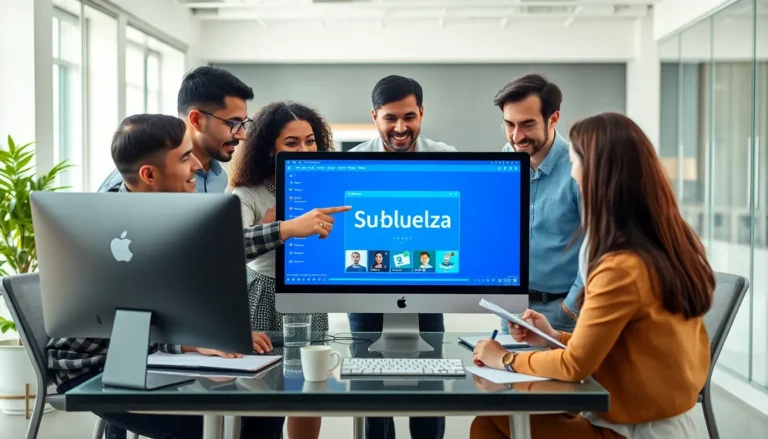In a world where knowledge is power, navigating the maze of educational resources can feel like trying to find the exit in a corn maze—frustrating and a bit overwhelming. But fear not! With the right strategies in your toolkit, transforming the learning experience from daunting to delightful is entirely possible.
Table of Contents
ToggleOverview of Education Resource Strategies
Education resource strategies encompass various techniques that enhance learning effectiveness. Prioritizing resource selection is crucial for optimizing educational outcomes. Effective strategies include integrating technology, promoting collaboration, and utilizing diverse materials.
Integrating technology, such as learning management systems and digital tools, streamlines access to resources. These platforms enable students to engage with content at their own pace. Promoting collaboration through group projects fosters teamwork and problem-solving skills. It enriches the learning experience by encouraging diverse perspectives.
Utilizing diverse materials—textbooks, articles, videos, and interactive simulations—cater to different learning styles. Offering variety accommodates auditory, visual, and kinesthetic learners. Accessing curated content ensures that students receive updated, relevant information.
Incorporating feedback mechanisms is essential for improvement. Assessing resource effectiveness allows educators to refine strategies for better results. Tracking student progress reveals areas needing attention and guides resource adjustments.
Establishing partnerships with local organizations can augment resources. Community involvement provides access to mentorship programs, workshops, and real-world experiences. These connections broaden educational horizons and expose students to professional opportunities.
Continuous professional development for educators enhances their ability to implement effective strategies. Staying current with educational trends equips teachers with innovative practices. Engaging in training sessions helps educators maximize available resources for optimal learning environments.
Focusing on a blend of technology, collaboration, diverse materials, feedback, partnerships, and professional growth can transform educational resource strategies into powerful tools for academic success.
Types of Education Resource Strategies
Education resource strategies encompass various areas that improve learning outcomes. Effective management of these resources leads to more enriching educational experiences.
Financial Resource Management
Optimizing financial resource management is essential for maximizing educational outcomes. Schools and institutions allocate budgets based on priorities. This funding can cater to essential programs or facility improvements. Tracking expenditures ensures financial accountability. Schools can create partnerships with local businesses to increase funding opportunities. Grant applications allow institutions to secure additional financial support. By managing their finances judiciously, educational institutions enhance resource availability.
Human Resource Allocation
Human resource allocation plays a crucial role in ensuring effective education delivery. Properly assigning skilled educators to various subjects optimizes student learning. Professional development opportunities for educators enhance teaching quality. Creating mentorship programs fosters collaboration among staff members. Involving parents and community volunteers further enriches the educational environment. By attracting experienced professionals, schools strengthen instructional support. Utilizing a strategic approach to human resource allocation leads to improved student outcomes.
Technological Resource Integration
Integrating technology into education transforms traditional learning methods. Educators use digital tools to facilitate interactive lessons. These tools include online platforms, educational apps, and virtual resources. Training teachers on effective technology use ensures successful integration. Technology promotes personalized learning experiences tailored to individual student needs. Utilizing analytics allows for ongoing assessment of student engagement. By leveraging technological resources, educational institutions enhance overall effectiveness.
Best Practices for Implementing Strategies
Implementing education resource strategies requires a structured approach. Focusing on specific areas like assessing needs and engaging stakeholders enhances effectiveness.
Assessing Needs and Goals
Identifying educational needs is crucial for effective resource implementation. Schools should conduct surveys and assessments to gather data on student performance and resource gaps. Setting clear goals based on this data allows for targeted strategies that address specific challenges. Utilizing frameworks like SMART (Specific, Measurable, Achievable, Relevant, Time-bound) ensures that objectives are practical and attainable. Regular reviews of these goals help adapt strategies as circumstances change. Monitoring progress ensures that resources align with evolving needs.
Engaging Stakeholders
Involving stakeholders fosters a collaborative environment. Educators, parents, and community members contribute valuable perspectives during strategy formation. Organizing workshops and meetings allows for open dialogue and idea exchange. Sharing success stories increases buy-in and enthusiasm for initiatives. Maintaining ongoing communication updates stakeholders on progress and challenges. Establishing partnerships with local organizations broadens support networks and enhances resource availability. Empowering stakeholders in decision-making nurtures a sense of ownership and commitment to educational success.
Challenges in Education Resource Strategies
Education resource strategies face significant challenges impacting their effectiveness. Identifying and addressing these challenges directly influences the overall learning environment.
Budget Constraints
Budget constraints limit the availability of essential educational resources. Many schools face funding shortages, affecting the ability to implement desired strategies. Financial management becomes vital as institutions search for innovative funding sources. Tracking expenditures helps ensure available funds are allocated effectively. Additionally, pursuing partnerships with local organizations offers additional support. Prioritizing these financial strategies enhances resource utilization, leading to improved educational outcomes.
Resistance to Change
Change resistance emerges as a common obstacle in implementing new resource strategies. Educators and staff often feel comfortable with established methods, hindering innovative approaches. Building a culture that embraces change requires clear communication regarding the benefits of new strategies. Engaging stakeholders fosters a sense of collaboration and shared purpose. Providing ongoing professional development equips staff with the necessary skills and confidence to adapt. Prioritizing these efforts cultivates an environment open to transformation, ultimately benefiting student learning experiences.
Future Trends in Education Resource Strategies
Emerging trends in education resource strategies showcase innovation and adaptability in learning environments. Technology integration plays a pivotal role, enabling personalized learning experiences tailored to individual student needs. Artificial intelligence aids teachers in analyzing data for improved engagement assessments, streamlining the learning process.
Collaboration among stakeholders is gaining traction. Educators, parents, and community members increasingly participate in decision-making processes. Workshops and collaborative meetings enhance communication, fostering a unified approach to educational initiatives. Schools that embrace this trend benefit from the collective expertise of diverse groups.
Diversity in learning materials remains critical as educators address various learning styles. Adaptive resources, such as interactive e-books and hands-on activities, cater to different preferences, ensuring all students receive the support they need. Research indicates that students retain information better when engaged with varied formats.
Sustainability in financial management is essential for long-term success. Adopting strategies that prioritize budget flexibility allows schools to allocate resources more effectively. Partnerships with local businesses and non-profits can provide alternative funding avenues, reducing dependence on traditional budgets.
Mental health awareness is becoming increasingly important in resource strategies. Incorporating social-emotional learning into curricula addresses the well-being of students, promoting a positive school climate. Schools that prioritize mental health initiatives observe enhanced student engagement and academic performance.
Overall, these trends emphasize the need for adaptable resource strategies that align with evolving educational demands. Prioritizing technology integration, collaboration, diversity in resources, financial sustainability, and mental health awareness ensures that education continues to thrive in a changing world.
Effective education resource strategies are essential for navigating the complexities of modern learning environments. By prioritizing resource selection and fostering collaboration among stakeholders, schools can create a more engaging and supportive atmosphere for students. Embracing technology and diverse materials not only caters to different learning styles but also prepares educators and students for future challenges.
As the landscape of education continues to evolve, staying adaptable and innovative will be crucial. By addressing budget constraints and promoting a culture of continuous improvement, schools can enhance educational outcomes and foster a strong sense of community. Ultimately, these strategies pave the way for a more enriching and successful educational experience.


